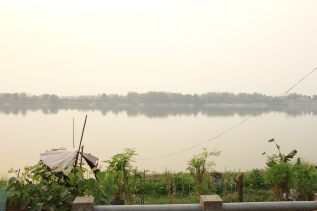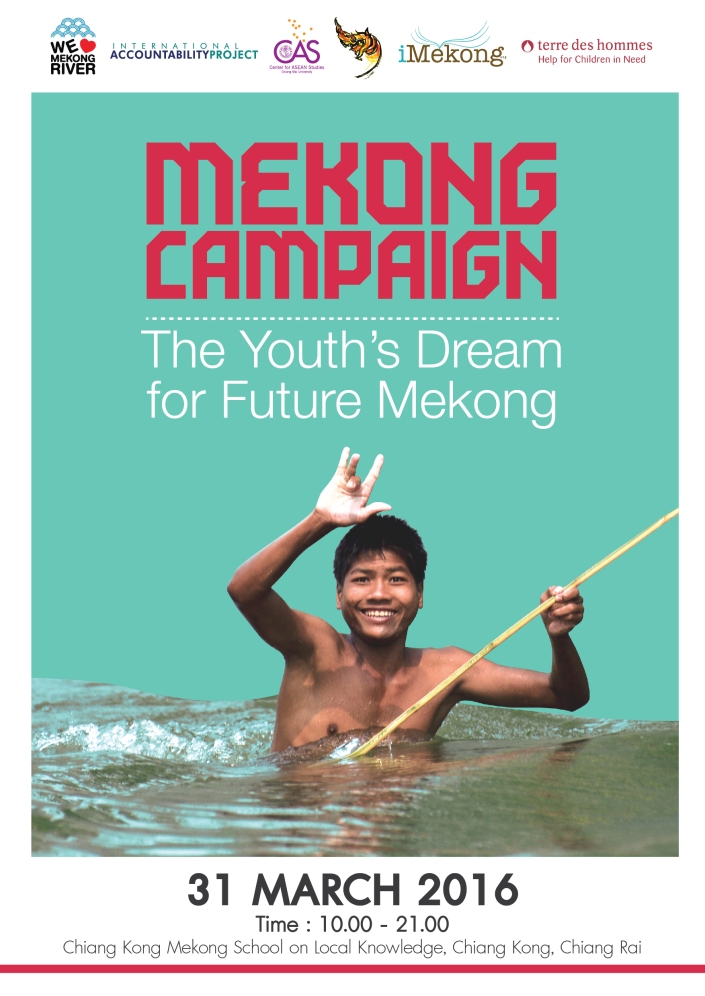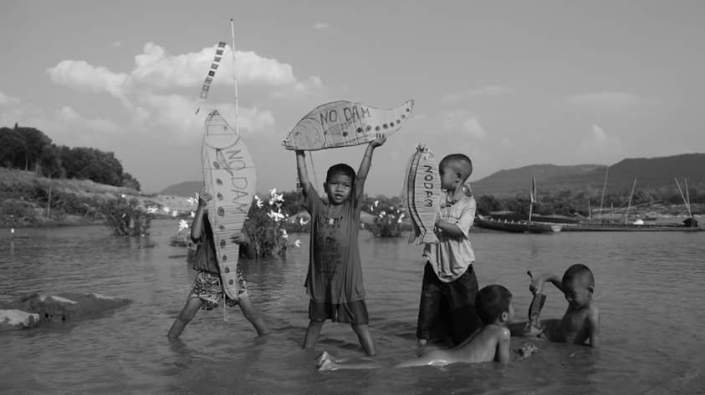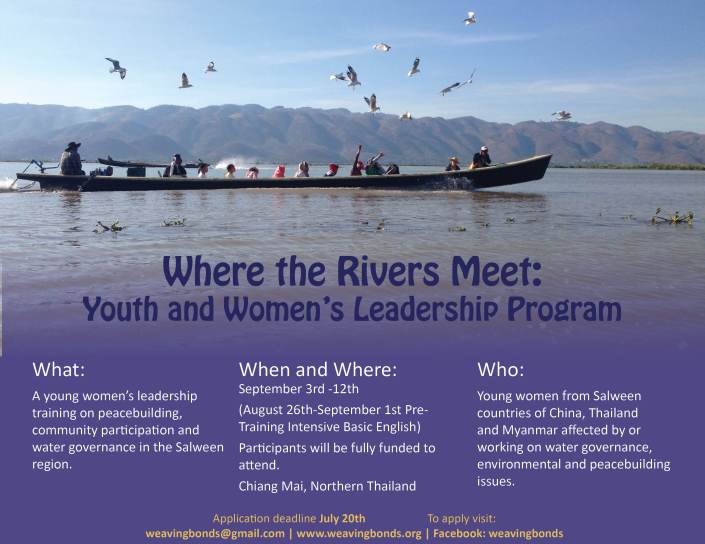Latest Event Updates
A Journey to Remembrance: Children’s Simple Story of Lives and the River
Mekong Youth Voices by Dhiramedhist Lueng-Ubon
“The municipality office is over there.”
“Just go ahead, right?”
“Ah, yes,” a 12-year-old girl stopped cycling to reply to a question from a stranger after he asked her for directions.
“Could I talk with you for awhile? I’m in search of a group of children who could share me a story,” the stranger continued the dialogue, but swiftly changed to another unanticipated topic.
“Sure, but what are we going to talk about though?” The short answer from the girl made him smile from ear to ear. “Just anything you wish; as you live at the bank of the Mekong river, your stories are all appreciated!” he promptly replied.
“Could my friends accompany us?”
“Yes, of course,” the guy was thrilled to bits once he heard the question which was also in his mind.
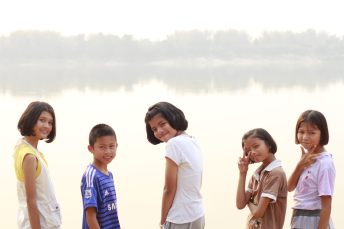
Actually, I was the guy in the above dialogue with a girl whom I accidentally met on the small lane alongside the Mekong River in the town of Phonpisai.
After my first day was hopefully (but later hopelessly) spent in the downtown of Nongkhai, roughly observing residents of the town to find out what should be brought to you as a story about the international river Mekong, I had no idea what should be written at the moment. Whereas information about the Mekong is nowadays really accessible (especially scholarly articles), only a few stories of ordinary children’s perspectives towards the river could be found on the internet, in particular those written by young people.
In the morning I went to the pier next to Thasadet,the first Indochina market in Thailand, just to let a story come to my mind. Standing next to the river, witnessing its level sharply raised as the result of China’s dam release a couple of days ago, I was thinking of my childhood when I was young.
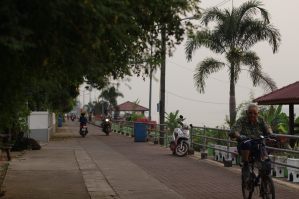
I was born and raised in a rural area of the northeastern Thailand where at least 8 hours of travel is needed for locals to experience the nearest sea beach. Among the very limited places where my family could afford as a vacation destination, Nongkhai was the first and only place that we visited together as a family, in particular when my grandfather was with us.
My hometown is not situated at the bank of the river;it takes 3 hours to travel there. No matter where a village is located, as long as it is a home to Lao community I am sure there is a story about the Mekong. We are all tightly connected – historically and spiritually – with the great river, as we have been for hundreds of years. In this fashion, my grandfather shared various stories with me that are linked to the Mekong. Some were repeatedly told, but they were all enjoyable for a child like me.
Instead of sharing my own stories, those brought to me by my loving grandfather, it is all in all much better to explore the more lively stories that are possessed by the children of today.
On an ordinary but super sunny afternoon, once my identity card was left as required at a bike rental shop, I grabbed a motorbike which was my only companion on the way to Phonpisai(40 kilometers from the heart of Nongkai), one of the Mekong towns in the Northeastern part of Thailand. As aforementioned, I was almost hopeless until I witnessed the flow of the river in the morning, at the point where I had been with my grandpa years ago, and was reminded of some of stories about the Mekong that were told by him when I was young. Hence my hope was rebooted, and any group of children was a target as my key informants. Phonpisai was chosen based on the fact that I wanted to explore an unfamiliar town, and it met this simple requirement of mine. My only knowledge about the town was that it is the best spot for tourists to be enchanted by the mysterious beauty of Naga fireballs.
Amy, the girl whom I met at first, dropped by each house to wait for and invite her friends. A girl named Pop and Korn,the youngest and only boy, didn’t believe that an outsider wanted to talk with them about their lives and the river.
“Excuse me bro, please come with me to tell my friend that you are really here with us,” June asked me after she came back from Pop’s house.
Finally, I had five of them together sitting under the big tree, in a temple that’s provided villagers and visitors shelter for years next to the Mekong River, and everything was ready to begin.
“Come a little bit closer,” I told them.
“I’m from Bangkok, seeking for children to share me any story about their lives and the river.”
Some background of mine was given. Their consent to be interviewed and to publish their stories as well as their photos was granted.
“Yes, this is my first time to be interviewed but my grandma was interviewed before, maybe you could talk to her also”, Noey informed me as I continued to learn more about their backgrounds. “She was asked about Naga fireballs,” she added. I replied to the girl, as she encouraged me to interview her grandmother, that talking with children just like them is expectedly and ideally enough for me, so there was no need to talk to her grandmother.
None of them looked nervous, everyone seemed so happy to be interviewed.
“Where is the river from?” “Do you know what countries people can see the river from?” I asked them.
Nobody could tell me where the origin of the river is, at first glance.
“Laos, Thailand, and…”, Pop gave me her answers, followed by June’s, “China,” and Korn’s, “Myanmar.” “Cambodia,” Noey added. The others laughed out loud, as they did not think her answer was correct.
She was not sure with her answer at the moment; I told her “yes, you’re right.”
What if somebody in Bangkok has never been to the river before, could you please help them to imagine the Mekong River? I challenged them.
“First of all, our river is so beautiful,” Noey led others, her big smile made me believe that she proudly told me the answer. “It’s a really big and deep river, villagers think it’s a home to Naga; it’s the river of friendship,” June described. Pop added that she used to swim in the river but only at its strand. “I was warned by my mom when I was younger that it’s dangerous to swim,” Noey shared her mother’s instruction. “But when I grew up, she lessened her rules. Now I can swim, I just need to inform her first and make sure it’s under an adult’s care.”
“Any of you really know how to swim?” I gave them a very simple question, but it seemed that it brought silence to the place for a minute. They were not sure if they could swim correctly. Actually, they all informed me that it’s common for children there to be warned not to swim, just in case no one is with them. However, their families used to bring them to the river. “In dry season, there is the so-called beach and everybody loves it,” June said. Pop told me that with a raft made of big bamboos, children could enjoy the river. Korn was the only one who has never been instructed to avoid swimming but still he has never swum, up until now at the age of 10.
Back to the first question of the river’s appearance, I further asked them for more details, “What is the uniqueness of the river?” Again, Noey influenced her friends with her view, “it’s because the Mekong is the only river on earth where you can see the fireballs.” The rest gave me a brisk nod to indicate their consensus. Continuing her explanation, she shared her experience with the fireballs: “They look like a football but just in the smaller sizes, some are pink, some are yellow.” Amy added, “Some are blended pink, yellow, orange and red.”
June said that the number of the fireballs has decreased year after year. “It is because people light fireworks, and this disrupts those Naga; last year I saw only 22 fireballs here,” Noey forwarded the idea of her grandmother as well as her experience to us. “I think I was at another spot, like in Pakkad, another district,” June commented.
At the End of Buddhist Lent day thousands of tourists, both Thai and foreigners, flow into Ponpisai and other spots along the river to experience the fireballs. These young children believe that the fireball shooting is a part of Naga’s celebration; even though none of them have seen the Naga which are, as they have heard, not scary, but powerful and huge and very kind snakes, the protectors of the people living along the river. “Probably, Naga is with us in our community, some of us may have seen but not noticed that it was Naga because it can turn itself into a human just like us,” June pointed out her assumption. Amy actively shared, “once, I saw a man jump into the river and even though I was at the riverside until the evening, I didn’t see him get out of the water.” Her story looked so powerful in enchanting the audiences. “He may be a Naga though,” she concluded.
“We all sold some food, snacks and soft drinks,” June answered my question about their roles in the Naga fireballs festival. Noey also helped her parents in their shop: “our shop sold soft drinks and grilled eggs.”
“My favorite thing in the festival is the firework itself,” June replied to me.
“Mine is all about food, I do love food,” Pop shared hers.
“I like travelers,” after listening to others’ answers for a while, Korn also shared his point.
“Yes, my mom was so happy because she could earn a lot of money from selling food and snacks on the day,” Pop interrupted.
“Springboard and roller coaster are my favorite part of the festive,” Amy said. As you can see, it is so outstanding that everyone loves the festival and really enjoys the day.
Aside from the festival, in the other 364 days all year round, everyone is invited to visit their hometown. I asked them to share some places to visit or activities that outsiders should never miss. Wat thai, a human-made Naga cave, having dinner and a decent stay at the river’s bank, and sightseeing were all recommended.
Additionally, in order to be a good tourist you should, as told by these boys and girls, make sure your garbage always ends up in a trash can, learn how to greet appropriately, visit as many places as you can, talk politely, don’t leave any message on the pavilions, and don’t throw anything into the Mekong River.
“The polluted water we used and left into the river shall always find their ways turn back to our lives somehow,” Pop started a new topic. Noey jointly contributed, “thus we should save water, always turn off the faucet.” Amy agreed with her friend on this point. Korn suggested that we should pay more attention to those toxic and chemical substances; they are very bad for our river. These were their answers to my question of what a child can do to save the river.
 “Yes, it is true that we can buy rice, in case there is no river, thus no water for cultivation, but it is, of course, better and cheaper to grow it ourselves,” Korn insisted, once I pretended to inform them that without the river, people could find other ways to survive. “As a result of the shortage of water, we all will die,” Pop said. June added, “It’s not only people who live nearby the river but everyone in Thailand that shall be affected severely.”
“Yes, it is true that we can buy rice, in case there is no river, thus no water for cultivation, but it is, of course, better and cheaper to grow it ourselves,” Korn insisted, once I pretended to inform them that without the river, people could find other ways to survive. “As a result of the shortage of water, we all will die,” Pop said. June added, “It’s not only people who live nearby the river but everyone in Thailand that shall be affected severely.”
It’s undeniable that some remembrances of one’s childhood could lead to unexplainable happiness whenever it comes to mind. Through the hour-long chatting with a group of children, not an interview with an expert or activist, you can feel the attachment between lives and the river, the memories of these boys and girls. In addition to those scientific studies and other academic perspectives, I hope these children’s ordinary and simple stories can help you to re imagine how real the significance of the Mekong River’s existence is.
Just imagine if the beautiful and peaceful Mekong River is replaced by hundreds of dam or runs dry forever. It will really be regretted because there is a linkage between the river and my remembrance of my grandfather. It was the only place we went together, and it was chosen by him before he passed away to be his last home, through scattering his ashes over it. Whenever I miss him, I wish I could turn to the riverside of the Mekong River, which is the origin of deep bounds of affection and impressions for millions of people in the region, including me.
Mekong Campaign 2016: The Youth’s Dream for Future Mekong
Concept: 100 youth representatives from the Mekong region have joined the campaign to save the Mekong River from a series of hydropower dams that threaten the region’s food security. Mekong countries have different political systems, and in many counties such as China (especially Tibetan regions along the Mekong), Laos, Vietnam, and increasingly Thailand, there is little space for public participation in development planning. Activists advocating for increased human rights, environmental protection, and the rule of law often face threats to their security, and access to information on these topics is extremely limited. It is thus crucial to provide space for Mekong youth to join together and campaign around the issues that are affecting their communities. .
The main campaign objectives include:
-
To promote exchanges, intercultural meetings and debates between young people and various stakeholders on the Mekong River and other issues in the Mekong Sub-region.
-
To build the advocacy and campaigning capacity of Mekong youth and to promote youth involvement in building an ASEAN community based on respect for human rights and the environment.
-
To raise the voices of youth in the Mekong region to advocate for stronger environmental and human rights protection and to build awareness on Mekong issues.
Date: March 31, 2016
Location: Chiang Kong Mekong School on Local Knowledge, Chiang Kong, Chiang Rai
Partners : Mekong Youth Assembly, International Accountability Program, The Center for ASEAN Studies, Chiang Kong Mekong School on Local Knowledge, iMekong, EarthRights International Mekong School
Supported by: terre des hommes- Germany
Video Workshop for Change and WriteShop for Change
Organizer: Mekong Youth Assembly, International Accountability Project, iMekong
Video Workshop for Change
Concept: Call for youth who are members and partners of the Mekong Youth Assembly who are interested in working in Video Advocacy to promote ecological child rights and youth participation in development in the Mekong region. There will be space for 25 youths from 6 countries, including Tibet/China, Cambodia, Laos, Vietnam, Myanmar, and Thailand to attend the training. The youth will acquire knowledge and skills about the video campaign process. The Video Advocacy Workshop will be a solution for youth to tell their stories and messages about ecological child rights and youth participation-related issues. Video Advocacy will be a process to communicate between people in the Mekong region and beyond. Six videos will be produced in either local languages or English.
To apply for the Video Advocacy, send a completed application to mekongyouth@gmail.com. You can download an application form at: 7.Mekong Youth Assembly Project Application
The Mekong Youth Assembly team will also contact a group of shortlisted persons for an interview. The list of successful participants will be finalized by March, 5th, 2016.
The Mekong Youth Assembly will cover all successful participants’ expenses that are related to traveling to and participating in the Video Advocacy, including trips to-and-from Thailand, accommodation and meals during the training.
Deadline for Applications: 26, February, 2016
Date: 27-29 March 2016
Place: Chiang Khong, Chiang Rai, Thailand
Participant: Youth 18-25 years ago from China, Myanmar, Laos, Cambodia, Thailand, and Vietnam
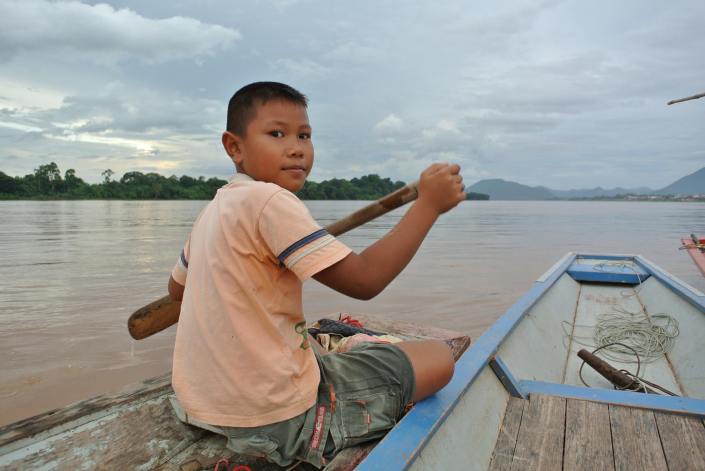
WriteShop for Change
Concept: Call Mekong youth members and partners who are interested in improving their writing skills and believe that writing can bring about positive change in society. We will focus on youth who have been actively engaging in social issues in the Mekong region, such as child rights, local livelihoods, the impacts of development projects, and environmental issues.
There will be space for 25 youths from the six Mekong countries, including China, Cambodia, Laos, Vietnam, Myanmar, and Thailand to attend our Writeshop for Change.
The youth participants will acquire knowledge and skills such as the key elements of an essay and how to write an essay and/or a news piece in a more effective and powerful way. The guest speakers will be young people from the Mekong region.
Mekong youth participants have many stories to tell about their lives and concerns, however, they still need to be equipped with some more writing skills and tools. We strongly believe that this writing workshop will help the Mekong youth to improve their writing skills and promote about positive attitudes about social challenges, ecological child rights and the environment in the Mekong region.
The youths will be working together and they are expected to produce a story. Ultimately, at least six stories on the subject of child life, environment in their hometown in both local Mekong languages and in English. The written, stories will be made ready to get published by the Mekong Youth Assembly’s coaching team-staffs.
To apply for the writeshop, send a completed application to mekongyouth@gmail.com. You can download an application form at: 7.Mekong Youth Assembly Project Application
The Mekong Youth Assembly team will also contact a group of shortlisted persons for an interview. The list of successful participants will be finalized by March, 5th, 2016.
The Mekong Youth Assembly will cover all successful participants’ expenses that are related to traveling to and participating at the writeshop, including trips to-and-from Thailand, accommodation and meals during the training.
Deadline for Applications: 26, February, 2016
Date: 28-29 March 2016
Place: Chiang Khong, Chiang Rai, Thailand
Participant: Youth 18-25 years old from China, Myanmar, Laos, Cambodia, Thailand, and Vietnam
FROM LEARNING TO EXPERIENCING
FIELD TRIPS TO HIGH SCHOOL IN THE REMOTE AREAS OF VINH LONG AND CAN THO
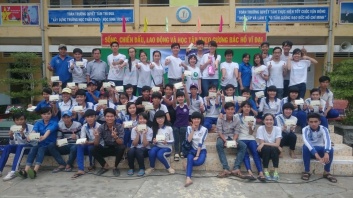
By NGUYEN KHIEM (The Voice of Vietnam Youth)
We, the Mekong Delta Youth understand, that no studying is no knowledge, but learning without practicing is even worse. Continuing the first phrase of the Unlimited Youth Collaboration for Developing A Sustainable Mekong River Project, is funded by Oxfam, we held two trips to the rural areas where 20 of our youths disseminated knowledge they attained from the first activity. Moreover, this is a chance for them to build a network with the younger generation and to evoke passion in protecting the Mekong Delta.
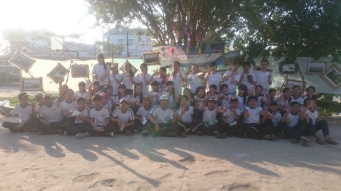
There were 80 participants – 40 males and 40 females – from two different high schools, one from Can Tho City and another from Vinh Long province. They took part in our second activity, which took us approximately two months to prepare. . Our youths had created various interactive games and activities, from the knowledge they gained in the first workshop, to educate the local students about the detrimental impacts from the Don Sahong Dam.
These are the three main activities that our youths held at the high schools:
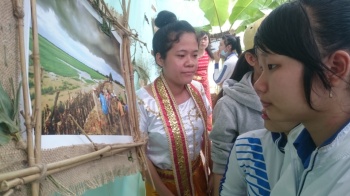
To start the programme: A photo exhibition of 20 pictures that illustrate four different themes – General Information of the Mekong River, The Livelihood Along the Mekong River, Hydropower Dam’s Impacts and The Mekong Delta.
During this stage, high school participants had to collect information to come up with an idea to paint their own picture of the Mekong Delta for the follow-up activity. Participants expressed their understanding of the Mekong through their arts. The third activity was an uninterrupted game.
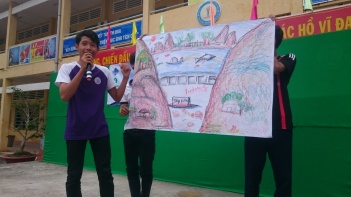
“Education is what remains after one has forgotten everything he learned in school” – Albert Einstein
Some people think knowledge is what remains after they have forgotten everything they have learned in school. Indeed, this was what the participants experienced after the three hour programme. Sitting around in a circle, participants discussed and shared the information they gained and how grateful they felt to have this learning experience. What they have learned was more than what we all expected.
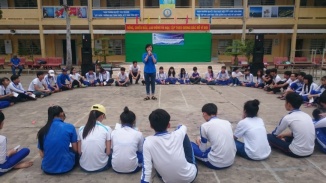
“I just realized that there are a lot of things happening in the delta, which is damaging our peaceful homes” – A student from Thoi Lai High School said.
Ending on a bright note, this program brought the youth together for future collaboration in protecting the delta. Twenty youths had a chance to actively learn, educate, and build a community to positively change the environment.
As one of the members of the Mekong Delta Youth Group said,
“We commit ourselves to protect the Mekong River together”
So we, “Cam kết cùng nhau bảo vệ Sông Mê Công”
TRAINING WORKSHOP PROGRAM ANALYSIS OF THE IMPACT OF DON SAHONG DAM TO THE PROSPERITY OF THE MEKONG RIVER
By NGUYEN KHIEM (The voice of Vietnam Youth)
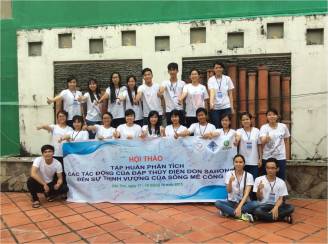
Twenty active youths from eight of thirteen provinces of the Mekong Delta had provoking discussions about Don Sahong Dam’s Impacts on the prosperity of the Mekong River, specifically the Mekong Delta. During this two day workshop, funded by Oxfam, student leaders collaborated and learned about the various, negative effects of dams on the livelihoods of the delta. Moreover, they learned about FPIC: Free, Prior and Informed Consent.
The participants represented diverse majors from different universities and colleges. Throughout the first day of the workshop, they perceived their own role in sustaining the region. Our goal was to motivate and stimulate their potential contribution for the future. At the end of the day, students illustrated their dreams for a better delta on their T-Shirts.

They were filled with a strong ambition to build solidarity among the youth in Can Tho city as well as connect with other youths in the delta. They aspire to create a large network of youth leaders in the Mekong countries with a focus on environmental issues. Furthermore, they expect more opportunities to build their capacity, as well as knowledge about our rivers, which is their life. Then, they can propagate the knowledge to younger generations.

The Mekong Delta Youth Group, a class of young leaders from the area, is going to organize an activity in late 2015 (the activity will be at two high-schools and approximately 80 students will have a chance to participate). In addition, this activity allows them to apply what they have learned from the workshop and to motivate the younger generations to participate in environmental protection.
From CRC to ECR: It’s called ‘inspiration and motivation’
By Dokkeo Sykham (The voice of Lao youth)
“What is CRC?” that was the question I asked myself since I first heard from one woman by chance during her conservation with her companies. I realized that might be a point I started to find out what CRC really means and why that is so important. Then a turning point of me on this issue was that when I got to know some inspired young human right defenders who working on child rights and environmental protection in Mekong region. Since then I got to know that CRC is one of conventions on human rights protection which recognized as international law and it is called ‘Convention on Right of a Child’. And that I started to find out little by little that how important to respect and protect child rights in every field from individual, family and society. But it was more challenged when I got the opportunity to work on Child Rights in the environmental field with some inspired young human right defenders, it is called ECR ‘Ecological Child Rights’ which aims to raise awareness and call to project developers to recognize the child rights violations caused by constructive developments. As I started little by little involved in this issue and now it is more than an ambition, it becomes intention and has clear vision to push this concept to be respected and recognized by Mekong countries as well as ASEAN level and it is needed to make sure that this could be enforced mechanism for project developers to take action on child rights violation caused by development projects attentively. Previously, seeing that many development projects in Mekong region such as hydropower, mining, coal power plants and land concession often result with displacement, environmental degradation, force eviction and loss of food security and livelihood and of course human right violations and that children, who they (country leaders) always say children are the future of the country, are most affected dramatically from development projects, but they are always overlooked by the group of people, who called themselves country leaders, who often say that children are the future of country. Other motivation for me to work on this issue might be seeing some inspired young human right defenders devoted themselves to work on this issue to make a change in the society, thus it is the point for me start understand and together work with them to make ‘ECR’ happen. From my experience working in the ground and see how essential to make ‘ECR’ happen in national and regional level, it encourages me to work on the issue and try to advocate in hoping that ECR will be recognized by all stakeholders and be able to put forward into the ASEAN’s agenda. Even it is laborious, we believe that what we are doing will make a change in the society and it’s not only for short term, but for sustainable term. “As we want to make a change and see things better, it spends times”, one young human right defender emphasized during the first group discussion on ECR concept.
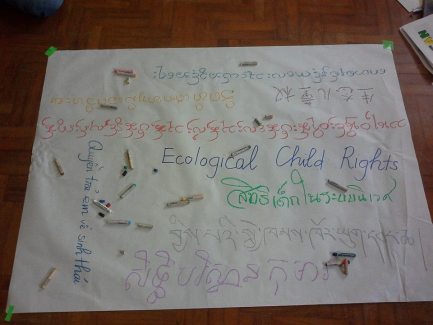
I am one of the youths in Mekong region that want to see a change in the society with respect the rights of people equally: child rights, youth rights, gender rights, adult rights, disable rights and elderly rights. Since I heard many leaders said that what they are doing is for next generation, for the security of the people especially for youth and children in the future, but what I see is contrary. There is no real or very rare that children or youths have the opportunity to raise their voices or participate on decision making genuinely to protect their rights and to decide what developments they want to see for ‘now and in the future’. As seeing many counties in ASEAN are still facing significant struggling of child right protection from abuses because of politic crisis, conflict, military occupied, and especially in the Mekong region which the destructive developments and freedom of expression are oppressed, it impulses me more and more to try to advocate for respects of the voices of people especially, in my homeland where there is a serious oppression of freedom of expression and increasing destructive development projects that will cause human rights violation an environmental degradation, and especially to children which it is need to be taken accountability from project developers and if governments do not take action on child right violation by development projects intensively, then they have to go back and ask themselves that what is mean by saying ‘we are doing for future generation’?
The Resettlement site: The mean of Better lives or more poverty?
By Dokkeo Sykham (The voice of Lao youth)
“They (dam developer) said that our lives would be better, we would have lot of money and good houses, we would be happier. But, look what we are now, we even could not think how our lives going to be in the future”, one old man expressed his hardship feeling that was repressed in his heart for long time.
Xayabuli Dam, was called as Mekong Dam by local people, is the first dam on Mekong mainstream which it is under construction in the country who aimed to be ‘battery of Southeast Asia’. The project’s developers, including Thai company Ch. Karnchang and the Lao government, have promised to build new resettlement homes for some villagers, compensate people for lost trees and gardens, and provide new job training. But, it was reported that those have not been sufficient[1].
Form the day project started construction until now, the hundreds of displaced people have already tasted the lives in resettlement sites with difficult struggles and the livelihoods of many villagers have not been restore to meet better lives as company promised yet. Almost 10 villages have already been relocated in resettlement sites. In next coming year, the rest of the villages in reservoir area that were listed as flooded villages, would be relocated.
The mean of livelihood ‘Before and after relocation’
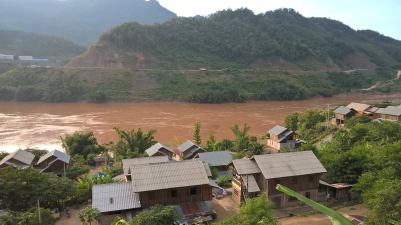
“No matter how long I have been staying here, I have no relationship or love to this place. The thing, I only dream to my spirit place which nothing could replace what we lost.” An old woman in the resettlement site strongly expressed with disappointment what they are facing.
Hearing villagers repeated same sentences over and over that “we really enjoyed our lives in old village, we had never thought before that our lives would be like we are facing now. We really disappointed”, it was really stuck and I could touch that how sadness they are. Many villagers said that their lives now could not compare what they had in the past. In the past, in their old village, they vocalized that they really enjoyed going to their wealthy farm in the upland and came back home with vary of vegetable. Catching fish with their traditional boats and using tradition fishing tools was culture of people who lived along Mekong River side. Villagers also said that they were really happy that their accentors established their villages there with rich place of food and income from generation to generation. “After came back from the farm, our community members especially women and children went to pan gold along Mekong riverside. It used to be our happy daily lives”, One woman retold about her life in old village with the feeling of missing her spirit home. Villagers in resettlement site reported that their lives now are more difficult than before because in new place, it lacks of agricultural land, difficult to access to the food source and many villagers are facing risk now, especially the vulnerable groups like poor families and disable people. Saying, the relocation of Xayabuli dam did not only destroy villagers’ livelihoods, but also ruined social lives. In the past, they treated each other like family by sharing food to each other or exchange things, but it rarely happened now because they are deficient. They even support their own family with extreme hardness. “I regretted it, because we lost our lively lives there”, one woman voiced out with sad feeling.
In fact, many villagers did not want to move from their old places, but they could not do anything about this. The only thing was they must accept it.“They could relocate us here, but they could not relocate our spirits. I still remember that the day we forced to move I heard many cried and I cried too”, an old woman spoke out with sadness and anger.
Dam developer only pushed forward the project to go further while let villagers behind to face insecurity of lives and many villagers just complained that “where is our better lives?”.
The process of compensation ‘Little’
“We already did what they told us to do, but they must do what they promised to do too”, an old man pointed out. Many villagers reported that the compensation that company gave to them was little and not enough for them to buy food since relocated to new resettlement, everything is money, unlike in their old place. In old village, they could find food without using money. “I can say that
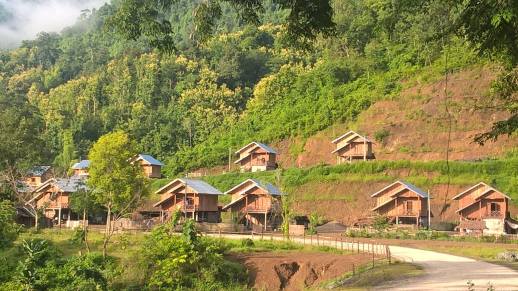
in the past we were rich of food. For example, if we wanted to eat fish, we just went to catch fish in Mekong river”, one respectful man strongly confirmed. Similarly, many villagers supported that now it is very difficult for them to do like they used to do before. So, it is no doubt that many villagers just go back to their old village to fish food and catching fish since in resettlement site does not afford them to do so. Villagers also claimed that every aspects of compensation are not only little, but the process of compensation especially job providing was very slow and complicated too. Worse, provided jobs could not make their lives better and many villagers claimed that those jobs could not replace what they used to do in the old village (Ban Khau). One old man also said comparatively that in past the families who were poor, they were not difficult like they are now, at least in the past they had rice field, and fish in river. But there is none now.
Did company really keep the promises?
“They told us they would give things like monthly stipends and rice for three year, but they only did for one year”, many villagers
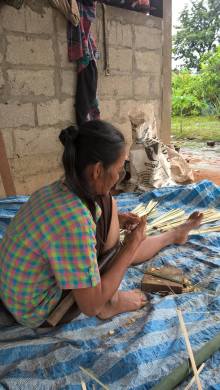
claimed the same words. As the company promised to villagers that they would do everything to meet requirement and would make better, but the fact is totally wrong. Company did not do what they agreed to do and that caused many villagers disappointed with the results. Since beginning, the company already violated the agreement physically and mentally that they did with villagers even though. It is very clear if we look at decree No. 192/PM on the Compensation and Resettlement of Development project. Then we can see that how much company violated this decree[2]. In fact, we could see it through our eyes from the reality in resettlement site and hearing from villagers. “We could not trust company anymore, they only talked about it, but they did not do properly. I have no faith on them anymore”, a young lady strongly complained.
It is also reported that there are no compensation for the loss of gold panning, fishing which villagers claimed that those were the main sources of making income.
The livelihoods ‘under insecurity’
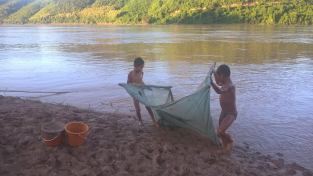
“How do you think about poverty alleviation”, I asked many villagers and almost of them said it means when their lives in the past. In the past, they said they did not need money to buy things because they already had food market in the forest and river and yes, they had gold along the creek in their village. The poverty alleviation policy that company and local authorities repeated over and over in resettlement site made villagers boring, and no faith on it. “It will not happen if our lives still facing like we are now”, old woman strongly opposed. Since several villagers were relocated until now, their lives are more and more difficult.
“With that little land, we could not make enough for our lives”, an old respectful man pointed out. They (company and government)
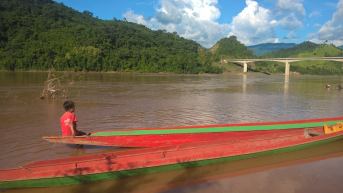
only gave little land to us and told us to plant only banana tree instead of planting rice”, He added. The problem already happened as Houy Souy village (known as Natoryai village now) are facing problem that many people claimed the land they got was very limited (only 0.75 hectare/household) and because of the economic development policy from the authorities, they needed to plant rubber trees which villagers claimed that it was wrong to do that. Villagers said they needed the land for growing rice, but company and government authorities did not agree and did not allow us to plant rice. “we had our own theory that was the principle that villagers had for many generations that we were born as farmers, we believe that that agricultural land is the most important for us, but those who came from outside only laughed at us for this idea”, some villagers added.
Almost of villagers in resettlement sites said that they really concern about their lives in the future which many villagers said that if their lives still have lot of troubles like they are having now, then who will come and solve to get rid of this terrible lives ?
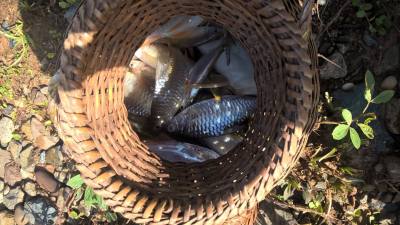
“We try to understand what government doing is to develop country, but we also want to have good lives. Our lives should not be to like this”, an old man pointed out. Saying, villagers did not oppose the development projects from government, but they need development projects that make their lives better not worse.
As the similar issue already happened caused by Nam Theun2 dam. In the years since thousands of villagers were relocated, they still struggle from the loss of their traditional livelihoods, having lost access paddy and widen fields, forest and surviving with small and limited scale of land. Also the fish stock in reservoir area has significantly declined[3]. What is the cost of the project really mean to these villagers since several have been bearing hardship from this project?
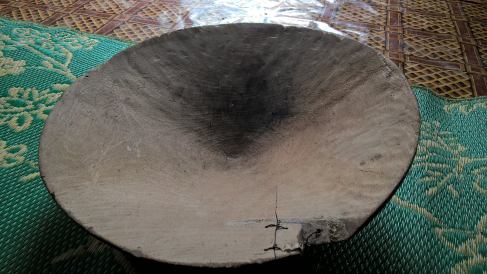
As villagers forced to satisfy all their valuable things: homes, culture, natural resources, government and company need to take action and find the way to solve the problem, not let them behind like they are acting now. And government needs to look back and answer the question by themselves that what dose economic development really mean as aimed to reduce poverty in this country if it finally results with thousands displace people?
[1] Radio Free Asia “Assistance for Villagers Resettled by Xayyaburi Dam to Last One Year”, Lat modified September 28,2015. http://www.rfa.org/english/news/laos/xayaburi-06182013164824.html.
[2] International Rivers “Resettlement activities at the Xayaburi Dam site have violated Lao law”, Last modified September28, 2015. http://www.internationalrivers.org/th/resources/the-xayaburi-dam-threatening-food-security-in-the-mekong-7675. See the attached files: Annex 2: Does the Xayaburi resettlement comply with Lao law? And Annex 3: Does the Xayaburi resettlement comply with World Bank standards?
[3] International Rivers “The World Bank and Dams: Part2. Dispelling Myths of Nam Theun”, Last modified October5, 2015. http://www.internationalrivers.org/files/attached-files/nt2_factsheet_2015_web.pdf
Ecological Child Rights Curriculum Workshop #1 Coming soon!
By Mekong Youth Assembly
The Mekong Region is rich in ethnic and cultural diversity, natural resources, watersheds and biodiversity. The Mekong River, or “Mother River”, is much more than just a natural resource. The river is the heart and soul of mainland South-East Asia. For the people whose lives depend on its waters, the river is a way of life, a home for the spirits, a social arena, a place where life unfolds and a source, not only of survival, but also of profound meaning. The river speaks of the past and of the future, of the eternally recurring cycles of nature, of the people living upstream and downstream, of survival, beauty and danger.
Each country in the Mekong region concentrates on getting benefits from the Mekong River by building large hydropower projects to produce electricity. As a result, the ecological system has changed. There is not enough water for agriculture. The people around the Mekong River have been the ones to suffer the impacts from these large hydropower systems. Irrespective of their age, they have had to relocate, and many children have suffered the effects of child labor and violence. Some countries fight against the local people to drive them from the project area. So many families have moved to other countries, where they become illegal immigrants. They have no rights, no quality education, no security, and face many conflicts.
Situation in Vietnam, government have development project plans for build deep seaport and hydropower plant more than 400 dams. The villagers have no rights to demand and participate in the agreement. The children and their parents get lots of impact from development project. The children had to relocate to new place and they got compensation but not enough. Many children became child laborers.
Peoples in Cambodia have to fight with big company from outside countries such as company from Vietnam. The company cooperated with government for land confiscation for do development projects, the villagers have low power and have no choice. They must move to other place under company control. They lose their land, home, job, livelihood, and their family. Many families broke up because they lose income, food security, they can’t feed their family. Many children become street children, low education, low security, bad health and have no future.
In Karen state, Myanmar has many development projects which come into the villages; Mining projects, Cement projects, Asia highway and large hydropower projects. All development projects have suffered the effects of child health, education, security life and death. Peoples some parts of Karen state are trying to protect their community but become involved in the war between Myanmar government and the ethnic minority.
Laos got peace country awards at the third level in the world. But in the reality, peoples don’t have rights for participating in development project or events discussed about bad things of government. They are living in fear, don’t have freedom rights for demand and shared opinion about all of development projects. Many time, child and youth got exchange opportunities such as in ASEAN Youth Forum but they couldn’t share and mention about development projects in their countries. Development project is a dangerous and sensitive issue, if anyone complains or demands on this topics some bad thing will happen to their life. Especially security, because we had examples such as Mr. Sombath Somphone who has shared Dam information, but after a few day he disappeared since 2012 until now.
China is the superpower country in Mekong region, China government and company supported building large development project in countries of Mekong region. In China they still have lots of development project plans, when they build the Dam project peoples had to move to other place, peoples died especially children.
Smile country for Thailand under the military control is not different from other countries in Mekong region. Peoples couldn’t do campaign, movement, meeting discussed about the problem of government management, development projects, environment issues and politic. It is the time for low power of population. Thai government and company are building large hydropower system in other countries such as Xayaburi Dam, Laos. Even Thailand had good constitution focus on participating in rights of population but it doesn’t mention about child participation, especially participating on development project.
Young people around Mekong region are concerned about child participation on environmental issues. Most of development projects have an impact on the environment, and the children are the first group to have suffered the effects of bad environment. But government and company never ask or keep space for child participation. Young people would like to build child participation on environment but they have a lack of knowledge. The Ecological Child Rights Workshop will develop knowledge skills for young people, continuing to work and build space for children in their own communities.
GOAL: To encourage, building capacity and promote the participation of the child focus on Ecological Child Rights and bring about changes in environmental concerns.
- Workshop target group:
- Youth-led groups and networks including
- Vietnam
- Laos
- Cambodia
- Thailand
- Myanmar
- Tibet/ China
- 20 youth group representatives in the Mekong countries participate the workshop
- Workshop Objectives:
- To provide information and knowledge about ecological child rights and youth participation rights for participants
- To develop an ecological child rights curriculum by using youth oriented and youth participatory method
- Workshop Duration: 29-30 August 2015.
- Location: Chiang Mai, Thailand
- Plan, Key Activities and Result:
| Main Activities | Out puts | Expected Results |
| Ecological Child Rights workshop | – ECR in Mekong region guide training course booklet has been published in March 2016.- 20 youths of Mekong region have attended ECR curriculum workshop and be able to share thoughts and fully participate in this curriculum development process in August 2015.- 20 youths of Mekong region understand ECR and can apply it in their communities.
– Youth have a chance to learn, exchange experience, and situation about ecological child rights and youth participation rights in each country. |
– A well-equipped regional youth network is established to lead ECR promotion and protection in the Mekong region.- Ecological Child Rights issues are well-known and well practiced in Mekong region. |
6. Expected Outcomes:
6.1 Children and Youth in Mekong Region become the active citizens, enjoy full participation in order to exercise to claim their Ecological Child Rights in development project in Mekong region .
6.2 Civil societies’ and communities’ capacity are enhanced to support ecological children’s rights by strengthening inter-generational networks and collaborations and/or movements add value to the work of their participants on Ecological Child’s Rights especially in development project in Mekong region that effect to their and community’s rights.
6.3 Policies and practices in their community affecting ecological children’s and young people’s rights duty bearers are more accountable for the fulfillment, protection and respect of children’s and young people’s rights. Policies are developed and implemented and the attitudes of duty bearers take into account the best interests and rights of the child.
Young Human Rights Defenders: From the Mekong Region to ASEAN
By Dokkeo Sykham (The voice of Lao youth)
“Even though we come here with different issues, we are here to achieve the same goal. We work to strengthen a common ground of respecting, promoting, and protecting human rights of all people in this ASEAN region,” said a young human right defender at the 2015 ASEAN Youth Forum.
These inspiring words given by one of our strong regional teams who welcomed all youths, in a small room at the first day of the ASEAN Youth Forum (AYF) 2015 in Kuala Lumpur, Malaysia.

Here, there were youth representatives from all ASEAN countries, namely, Cambodia, Vietnam, Laos, Thailand, Burma/Myanmar, Malaysia, Indonesia, Philippines and Singapore. They came to share the issues from their experiences and to exchange opinions enthusiastically.
During the forum, various issues came up related to human rights abuses including women and child abuses, democratization, freedom of expression, gender, education, religions and environmental issues.
Young participants discussed how could we work together to prevent human right abuses, and to promote people’s rights across borders. In the ASEAN community, any problems happening in one country are not isolate from other countries, but they are really relating to the whole region.
At the 2015 ASEAN Youth Forum, I was surprised about many cases that my fellows shared. They talked about their experiences and opinions. Some cases happened in our ASEAN region for a long time, but only I heard about those things at the Forum. That made me think of how much I really know about ASEAN, and how much the other youths in my country know about these cases.
In my country when we talk about ASEAN, my youth friends often mention that ASEAN community will be a good process for economic development, but they rarely mention about environmental and human rights violations that typically comes with economic development projects in our region.
I asked myself, how many of them would understand or even paid attention to human rights and environmental issues? Is this lack of understanding part of our political and freedom expression limitation? Are there laws that restrict youths in my country to raise these critical issues?
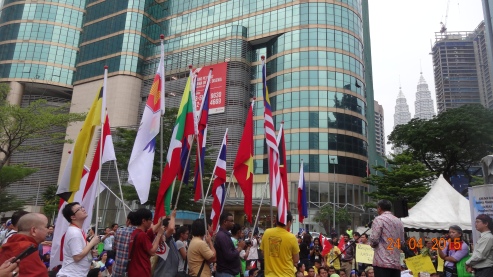
“How can we become one community while some countries are still fighting on the border and use military power to oppose each other because of high authorities want to get benefit from that and fight to get more territories?” a friend who live in conflict area of Aceh, Indonesia, strongly expressed.
From that point, I totally agreed with her and cannot stop thinking how can ASEAN be one community peacefully while there is still violence and oppression elsewhere?
During the two-day ASEAN Youth Forum, I also shared about destructive development projects that have violated people and environment for the past decade in the Mekong Region.
I mentioned how much hydropower dam projects have threatened people and will kill the Mekong River, the mother of all rivers in Thailand, Laos, Vietnam and Cambodia. Our countries share the same river.
A youth from Cambodia clearly expressed that “over 60 million living in Thailand, Laos, Cambodia and Vietnam, all sharing the Mekong River; they use the river to sustain their livelihood. I am also one of those people who don’t want to see dams kill the Mekong River and the people.”
Another ASEAN fellow from Malaysia further explained the situation happening in his community in Sarawak, where the Bakun and Murum Dams brought disaster to the environment and the people who live there. He said that the case like Bakun dam is very sad, the villagers did not receive a fair compensation from the government after the relocation.
He continued “we already had a lesson learned from the Bakun dam and how bad it was. Why then do they (dam developers) still want to build many more dams in our community?”
“The benefits are not for community in Sarawak, the dam only destroyed our livelihoods. From now we will not allow the next dam to be built, the Baram must be stopped”, he said.
I then realized that in our region, hydropower is not only a problem for our Mekong countries in this region, but it is a crucial problem of the whole ASEAN region.
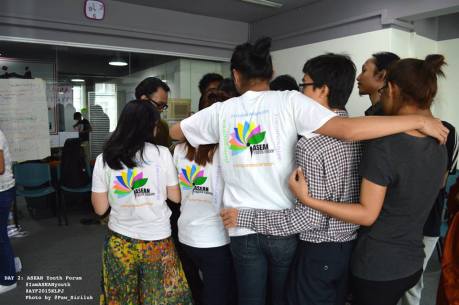
When I was a student at the Mekong School, I learned a lot about how destructive development projects such as hydropower dams and mining can threaten the well being of the environment and the people along the Mekong River.
Therefore, when I heard stories from ASEAN friends at the AYF of how a development project violated peoples’ rights and destroyed their livelihood, I thought “we have many things to do together, to do some networking and to build up a network to protect our environment as well as our peoples in this ASEAN region”.
Many youths from ASEAN are very brave to stand up to claim their rights. Many young human right defenders are facing risks, but they do not give in or give up. We have experienced and seen many human right defenders are threatened by forced disappearance and even got arrested, and were killed.
For example, a case of Mr Sombat Somphone, he was forced-disappeared in Laos, in 2012.Stilltoday, we do not know where he is at the moment. Also, a recent incident in Burma/Myanmar, students were arrested and tortured after they protested against the Education Bill.
What I want to see from an integrated ASEAN community is the security of people especially youth human right defenders, to ensure that they can protect their rights and be treated without any discrimination. Specifically countries under oppressive regimes, young human right defenders protection should be emphasized on the ASEAN’s agenda.
It means that young human rights defenders can feel safe in continuing working in their community, countries, and in the ASEAN region.
We are the youth of ‘Now’; we are part of the ‘society today’. We are working towards for a better world. We have ability, energy, and passion to participate in all decision-making procedures, because we want youths’ voices to be included in all policies that affecting us.
About the author:
Dokkeo Sykham is an independent researcher. She is based in Laos focusing on environmental and social impacts from hydropower development.
Where the Rivers Meet: Youth and Women’s Leadership Program (YLP)
Program Description: เนื้อหาของโปรแกรม
Where the Rivers Meet is a regional programof Weaving Bonds Across Bordersto empower youth of the Mekong and Salween regions to take leadership roles on issues related with peacebuilding, community participation and water management both within communities and across borders.
ณ ที่แม่น้ำบรรจบกัน เป็นหนึ่งในแผนงานของ สานสัมพันธ์ข้ามพรมแดน (Weaving Bonds Across Borders) เพื่อเพิ่มศักยภาพให้กับเยาวชนในภูมิภาคลุ่มน้ำโขงและแม่น้ำสาละวิน เพื่อให้เยาวชนเหล่านั้นทำหน้าเป็นผู้นำในการเคลื่อนประเด็นต่างๆ ที่เกี่ยวข้องกับการสร้างสันติภาพ การมีส่วนร่วมของชุมชนและการรณรงค์ในชุมชน และธรรมาภิบาลการจัดการน้ำ ทั้งในระดับชุมชนและข้ามพรมแดน
Our Youth and Women’s Leadership Program (YLP) will bring young women from the Salween region countries to learn peacebuilding, leadership and community participation skills through a training, leadership development and networking program. Through this project, we will build the leadership skills of young women to support their communities and alsosupport friendship and network building between the Salween region of Thailand, Myanmar and China.
โปรแกรมสร้างผู้นำเยาวชนและผู้หญิง (YLP) ของพวกเรา มุ่งที่จะนำพาเยาวชนผู้หญิงจากประเทศลุ่มแม่น้ำสาละวินไปเรียนรู้เกี่ยวกับทักษะของการสร้างสันติภาพ ภาวะความเป็นผู้นำ การมีส่วนร่วมของชุมชนและการณรงค์ในระดับชุมชน โดยผ่านการอบรม การพัฒนาภาวะผู้นำ และการสร้างเครือข่าย ในโครงการดังกล่าวเรามุ่งที่จะสร้างทักษะภาวะผู้นำของเยาวชนหญิงให้ทำงานกับชุมชนของตนเอง และเกื้อหนุนการสร้างเพื่อนมิตรและเครือข่ายอนุภูมิภาคแม่น้ำสาละวินในประเทศไทย ประเทศเมียนมาร์ และประเทศจีน
Training/Workshop:
12 participants will be selected to attend a 10 day young women’s leadership training in late August/early September to take place in Chiang Mai, Thailand. Training topics are subject to change but may include:
– Peacebuilding, Teambuilding and Cross-Cultural Understanding
– Gender and Leadership Skills for Young Women
– Field Trip to Local Communities
– Community Participation on Water Management (Community-Based Research/Local Knowledge, Communication and Media Skills)
– Project Planning and Design
การอบรม/การประชุมเชิงปฏิบัติการ
ผู้เข้าร่วมจำนวน 12 คนจะได้รับการคัดเลือกให้เข้ารับการอบรมด้านภาวะผู้นำของเยาวชนหญิง เป็นเวลา 10 วัน ในช่วงปลายเดือนสิงหาคมถึงต้นเดือนกันยายน สถานที่การอบรมจะอยู่ที่จังหวัดเชียงใหม่ ประเทศไทย ส่วนหัวข้อในการอบรมนั้นมีเป้าหมายเพื่อการเปลี่ยนแปลง ซึ่งได้แก่:
– การสร้างสันติภาพ การทำงานเป็นทีม และการทำความเข้าใจข้ามวัฒนธรรม
– เพศสภาวะและทักษะการเป็นผู้นำสำหรับเยาวชนหญิง
– การลงภาคสนามลงชุมชนท้องถิ่น
– การมีส่วนร่วมของชุมชนและการรณรงค์ในชุมชนต่อธรรมาภิบาลการจัดการน้ำ (การวิจัยบนฐานชุมชน/ความรู้ท้องถิ่น ทักษะการสื่อสารและการใช้สื่อ)
– การวางแผนและการออกแบบโครงการ
Alumni Program: โปรแกรมศิษย์เก่า
Participants will join the network and will be supported by staff to engage in ongoing networkia mini-grants program, participants will also be able to apply to receive small seed grants to do projects related with peacebuilding, environment and water management issues in their communities
ผู้ที่เข้าร่วมจะเข้าร่วมเป็นส่วนหนึ่งของเครือข่ายและจะได้รับการสนับสนุนโดยทีมพี่เลี้ยง ด้วยการส่งเสริมให้เป็นส่วนหนึ่งของการสร้างเครือข่ายและกินกรรมในระดับภูมิภาคที่เกี่ยวข้องกับการสร้างสันติภาพ ประเด็นข้ามพรมแดน และธรรมาภิบาลการจัดการน้ำ โดยจะโปรแกรมทุนขนาดเล็ก ซึ่งผู้ที่เข้าร่วมก็จะสามารถสมัครรับทุนสนับสนุนเพื่อทำโครงการที่เกี่ยวข้องกับการสร้างสันติภาพ สิ่งแวดล้อม และธรรมาภิบาลการจัดการน้ำในชุมชนของตนเอง
Participants/Selection Criteria:
- Young women from local communities, CSOs, or NGOs in Salween countries of China, Thailand and Myanmar, particularly those affected by or working on issues related with water management, environmental and peacebuilding.
- Interest and enthusiasm for peacebuilding, environmental protection and community participation.
ผู้ที่เข้าร่วมการอบรม/เกณฑ์การคัดเลือก
- เยาวชนหญิงจากประเทศลุ่มแม่น้ำสาละวิน อันได้แก่ จีน ไทย และเมียนมาร์ โดยเฉพาะผู้ที่ได้รับผลกระทบหรือเป็นผู้ที่กำลังทำงานเกี่ยวข้องกับประเด็นธรรมาภิบาลการจัดการน้ำ สิ่งแวดล้อม และสร้างสันติภาพ ซึ่งเป็นเป็นผู้ที่มาจากชุมชนท้องถิ่น องค์กรประชาสังคม และองค์กรพัฒนาเอกชน
- มีความสนใจและกระตือรือร้นต่อประเด็นการสร้างสันติภาพ การปกป้องสิ่งแวดล้อม และการมีส่วนร่วมของชุมชน
Dates and Location
- September 3rd -12th (August 26th-September 1st Pre-Training Intensive Basic English Support)
- Chiang Mai, Thailand
เวลาและสถานที่
- วันที่ 3 – 12 กันยายน (26 สิงหาคม – 1 กันยายน การสอนภาษาอังกฤษแบบเข้มข้นก่อนการอบรม)
- เชียงใหม่ ประเทศไทย
Cost ค่าใช้จ่าย
Participants’ costs of travel to/from Chiang Mai, Thai visa, accommodation and meals during the training will be funded.
ผู้ที่เข้าร่วมจะได้รับสนับสนุนค่าใช้จ่ายในการเดินทางไปยังเชียงใหม่ วีซ่า ที่พัก และอาหารในระหว่างการอบรม
Application Process
- The deadline to apply is July 20th. For more details, see application form below.
ขั้นตอนการรับสมัคร
- การรับสมัครจะสิ้นสุดวันที่ 20 กรกฎาคม สำหรับรายละเอียด ดูที่แบบฟอร์มการรับสมัครด้านล่าง
YLP Application Form แบบฟอร์มการรับสมัครโปรแกรม YLP

